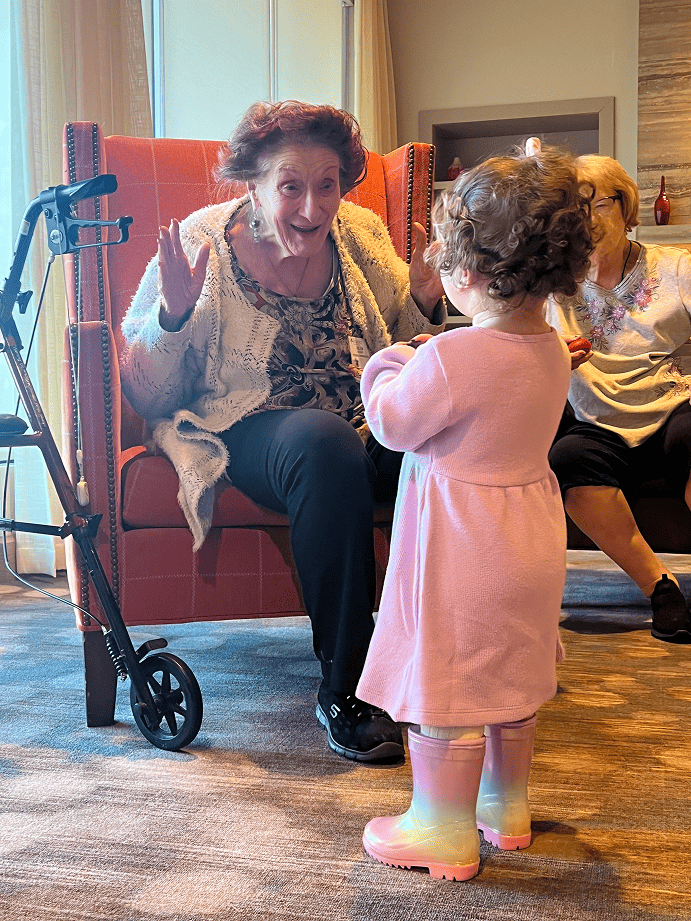Why Toddlers and Seniors Belong Together

When toddlers and seniors share music, it’s more than a sweet photo-op. Something deeper happens. Scientists call it co-regulation: as people sing or move together, breathing and rhythms align. That’s part of why choirs feel so good — and it’s what you see when a two-year-old with a drum and an eighty-year-old in a wheelchair lock eyes and grin.
What toddlers gain
For kids, being welcomed into a senior community is quietly transformative. The slower pace invites patience and empathy. Smiles and encouragement build confidence. And the setting itself teaches that public spaces can be joyful and shared.
Parents often tell me their toddlers leave calmer than they arrived. Research echoes this: children in intergenerational programs show stronger self-regulation and social awareness than peers in single-age settings (Journal of Intergenerational Relationships, 2017).
What elders gain
For residents, the benefits are just as profound. Weekly classes become small rituals to anticipate: the familiar songs, the little triumphs, the sight of kids running joyfully through the room.
“This is the best thing they ever did here.” — Dan, senior resident
Studies confirm what Dan feels. A meta-review of active music-making in older adults found measurable improvements in mood, memory, and even coordination (Frontiers in Psychology, 2020). Pat, another participant, put it simply:
“It’s wonderful — I think it’s so wonderful that this organization does so much for the children and their parents.” — Pat, senior resident
For some, the joy is in the sheer entertainment:
“It’s a riot watching them. I’m not always up at that time. It’s funny, really funny.” — Miriam, senior resident
And Julie offered her wry take:
“This is the best thing ever. The absence of small children and dogs… enhances this place greatly.” — Julie, senior resident
Tiny gestures, big impact
The real magic shows up in fleeting moments: a toddler running down the aisle of wheelchairs, handing out high-fives as residents beam; a quiet child offering their shaker to a neighbor; or the time a resident’s visiting family wandered into class. Even the 8- and 9-year-olds danced, and at one point the resident’s twin sister joined in. Suddenly three generations were moving together, lifted by the children’s joy.
These aren’t just “cute” moments. They’re community being built in real time — kids practicing generosity, elders reclaiming vitality, families remembering they belong.
The bigger picture
Across the world, intergenerational music programs are gaining recognition. Canadian residences report that shared classes reduce loneliness and improve staff morale (All Seniors Care). In the UK, outdoor music installations have been designed to bring all ages together (Percussion Play).
Classical music, too, has its role. Far from elitist, it offers clear contrasts — loud/soft, fast/slow, major/minor — that toddlers grasp intuitively. Exposure to great melodies is known to boost focus, memory, and joy. Seniors recognize the tunes, children delight in the playfulness, and everyone finds common ground.
Want to experience it?
If you’re a parent or caregiver, join a 45-minute class in Providence, Melrose, or beyond. You’ll see the joy for yourself.
If you’re a senior home or program director, we’d love to bring Bach & Boogie to your community. Reach out through our contact form to learn how.